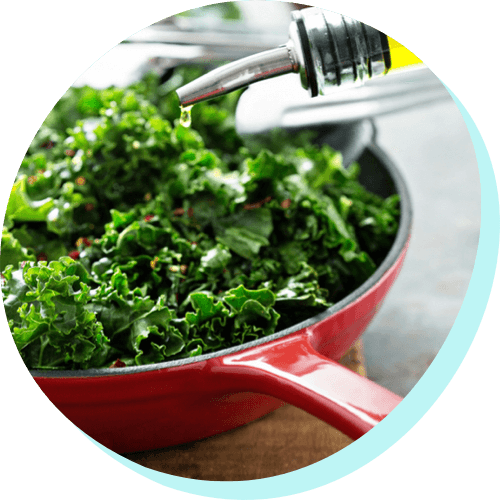When it comes to veggies, you can’t get much healthier than dark,leafy greens. Kale, in particular, is a superstar — it’s loaded with different vitamins, calcium, and other nutrients. Problem is, says Kristin Oja, RD, RN, and founder of STAT Wellness, cruciferous vegetables like kale are also rich in prebiotic fiber and raffinose, a sugar that remains undigested until it reaches your large intestines, where bacteria breaks it down and ferments it, explains Oja. Enter, gas — which for some people, comes with bloating and abdominal discomfort. But you don’t have to give up your favorite kale salad or steer clear of this veggie for good. These simple strategies will let you have your kale and eat it too.
How to Make Kale Easier on Your Stomach
Cut kale into smaller pieces
This may sound obvious, but the way you cut kale can really impact how your body processes it, explains Oja. Smaller is better — the goal is to create tiny pieces so it’s easier for your teeth to start the process of mechanically breaking down the kale. “I always recommend starting with a ‘chiffonade cut,’ which first destems the greens, and then roll a stack of the leafs, like a cigar, running the knife through at a quarter to half-inch segments to make spiral ribbons,” says Ali Miller, RD, LD, CDE, and author of The Anti-Anxiety Diet.
Massage your kale — or otherwise change its texture
Yep, you read that right. Kale should be massaged, or rubbed down spa-style, to make it a little easier to chew. “Start with sprinkling raw kale ribbons with Himalayan salt, then use both hands to crunch and twist them in a bowl,” says Miller. “This enhances nutrient absorption and helps break down the dense fibers.” So you will likely experience less bloating or stomach distention after massaging it.
Cook kale instead of eating it raw
Sautéing, steaming, or even baking kale can make it easier to consume. “It helps reduce the volume before you eat it, making it a bit easier on your stomach to break down,” says Tyffanie Ammeter, MS, RDN, CDN. “It also increases the surface area, allowing its nutrients to be better absorbed by the body.” One thing to note though, Ammeter says, is that it is easier to eat more cooked kale than raw kale, so don’t go overboard, or you may shock your system.“A good rule of thumb is starting with about half a cup to see how you feel and give your body time to adjust,” says Ammeter.
Eat smaller portions
If a huge kale salad leaves you in pain, Ammeter says to swap that for a grain bowl that only contains a small portion of raw kale. You could also do a small side salad instead of a full entrée size. And when you’re fixing yourself a kale salad, always remove the middle rib, as it tends to be extra tough, fibrous, and bitter-tasting.
Switch to a different type of kale
“Curly kale is very tough and fibrous, making it hard for our stomach to break down,” says Ammeter. She recommends trying a smoother variety, like Tuscan kale.
Baby kale is also something to look for at your local market or grocery store. “These young vegetables are smaller and less tough than mature versions of the plant,” says Ammeter.
Take Gas-X when any issues with kale arise
Even if you follow all of the above tips, kale can still be hard on your system. Keep Gas-X Maximum Strength Softgels on hand for when gas or bloating strikes. Gas-X has the #1 doctor recommended ingredient for gas relief among OTC brands, and relieves pressure, bloating, and discomfort — fast.





